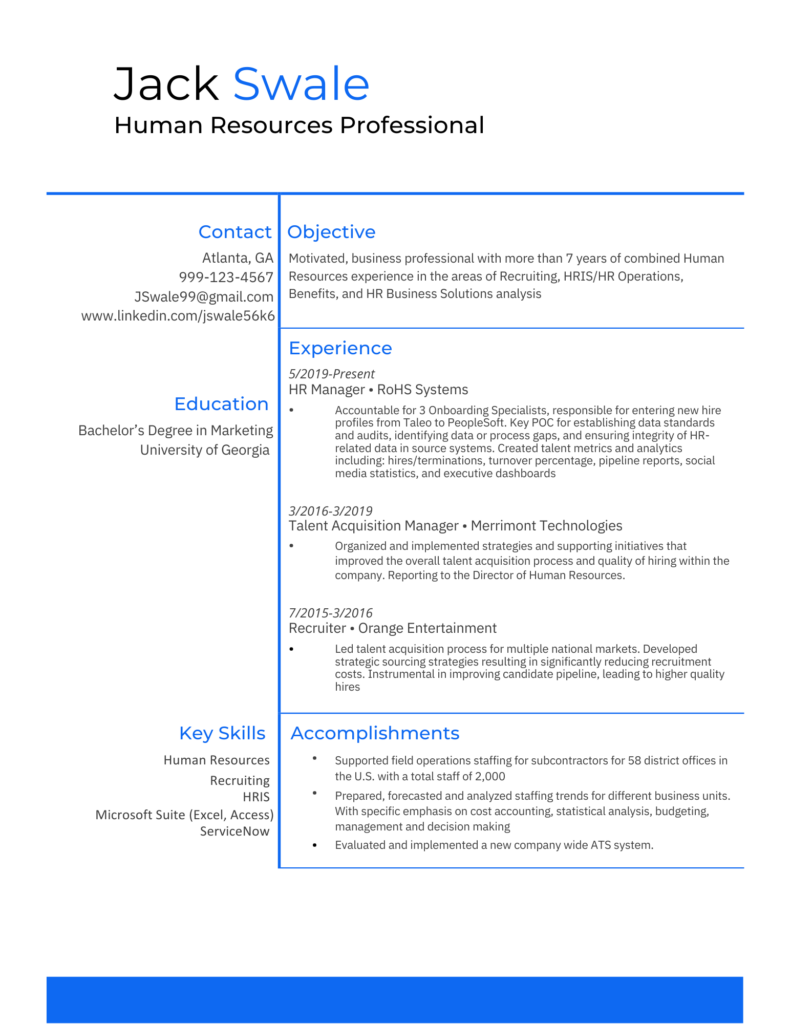What is a modern resume?
A modern format gives candidates more flexibility in how they convey their professional qualifications. It’s a contrast to the simple or chronological resume, which follows a more rigid, text-based structure with conventional formatting and fonts.
These resumes might make use of creative elements like color, newer fonts, graphics, and images. Its sections may vary from one candidate to the next. In fact, the appearance of a modern resume can vary quite a bit depending on the candidate and the industry.
Who should use a modern resume?
- Anyone in progressive fields like marketing or tech
- Candidates applying to companies that value outside-the-box thinking, like startups
- Applicants looking to set themselves apart with a creative presentation
- People with design skills who can create an aesthetically pleasing layout, or who are willing to hire someone to do so
Who shouldn’t use a modern resume?
- Candidates in more conventional fields like government, finance, and law.
- People who are more comfortable working with a traditional, text-based format.
Modern resume format and key components
There’s no single standard for the modern format. That’s one of the things that makes it an appealing option– you can customize it to fit your needs, style, and voice. You’re able to change parts based on things like how much work experience you need to include and how many specialized skills you want to showcase.
While the resume components and their order may vary from one modern resume to the next, here are some of the key items you’ll probably want to include:
- Contact information
While our example resume keeps the traditional contact details – name, address, phone number and email – a modern resume gives you some flexibility with the type of contact information you provide. If you’ve built up a following on social media or blogging about your industry, for example, you might want to include your TikTok handle or blog URL if it relates to the job. Since remote work is becoming more and more commonplace, including your physical address is less of a necessity. - Objective or summary
This is a brief statement that gives the hiring manager a quick summary of your qualifications and/or what you are looking for. You can use it to touch on your core skills, amount of work experience, or specific areas of the field you are interested in. This is a great place to work in keywords from the job description, we targeted ‘Recruiting, HRIS, HR Operations, Benefits, and HR Business Solutions‘ in our example.
- Education
Include the name of the institution and the degree you obtained. You can also use the education section to list any professional courses or training you’ve completed in addition to your degree. - Experience
This section will likely make up most of your resume, so you want to be sure you’re using consistent formatting. In our example, this would be italics for the dates of employment, a slightly larger point font for the job title and company, and bullet points for the accomplishments. When building out your job descriptions, don’t just list your duties. Use action words to describe your accomplishments like identified, created, organized, implemented, and developed. - Skills or accomplishments
Our sample resume splits skills and accomplishments into two distinct sections, which makes sense for this particular candidate. Depending on your own professional accomplishments, you may want to combine these two sections. This can be a strategic choice for recent grads who don’t have a long list of professional achievements to highlight.
Need help crafting a resume?
Build your modern resume today and get hired faster!
